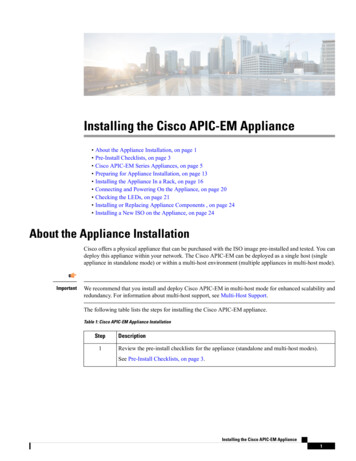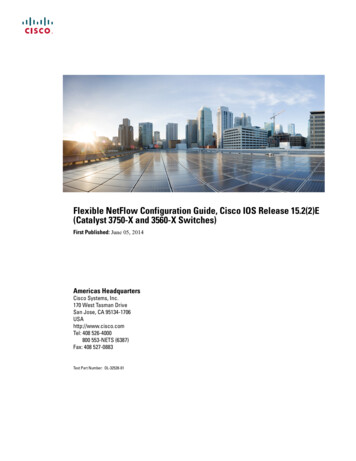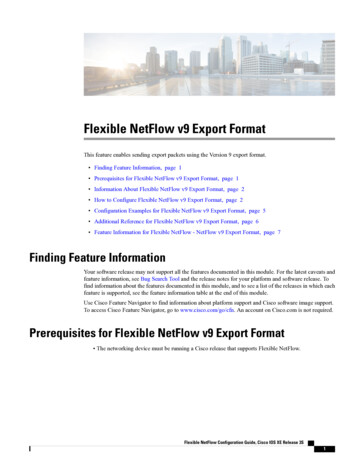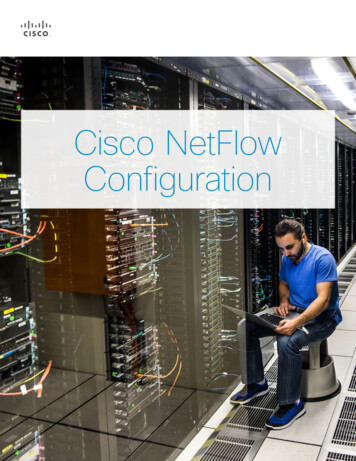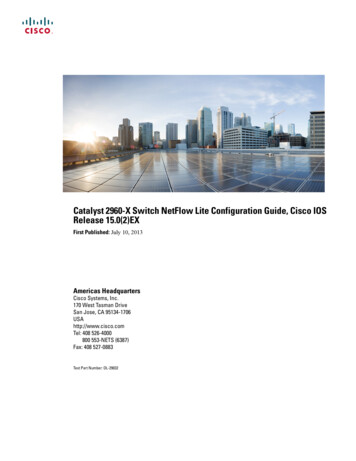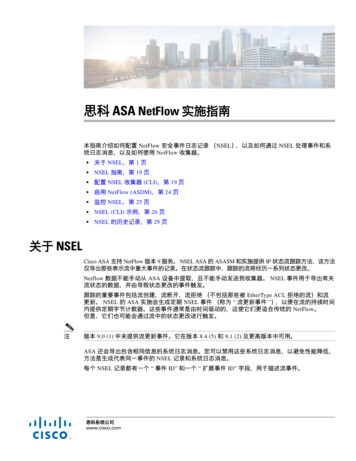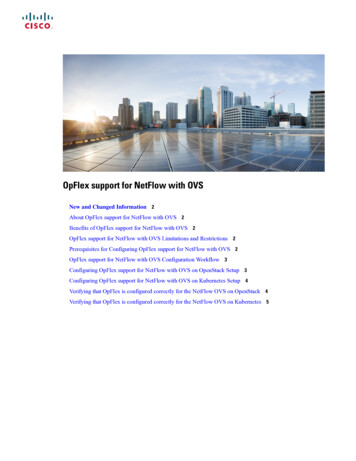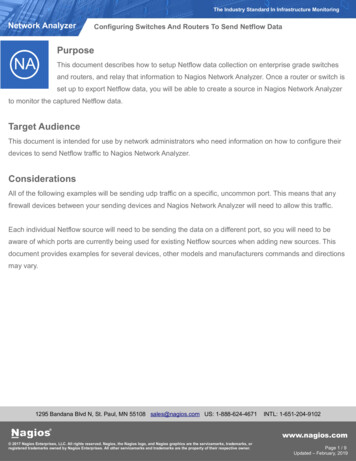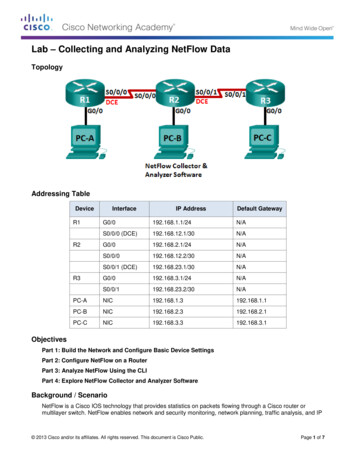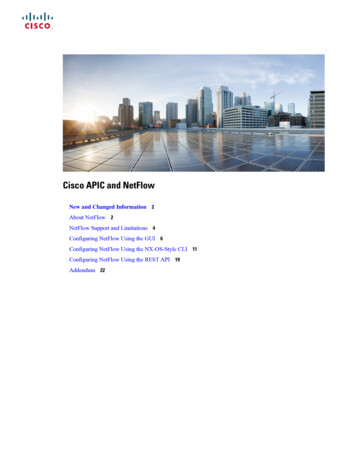
Transcription
Cisco APIC and NetFlowNew and Changed Information 2About NetFlow 2NetFlow Support and Limitations 4Configuring NetFlow Using the GUI 6Configuring NetFlow Using the NX-OS-Style CLI 11Configuring NetFlow Using the REST API 19Addendum 22
Revised: March 10, 2021New and Changed InformationThe following table provides an overview of the significant changes up to the current release. The table does not provide an exhaustivelist of all changes or of the new features up to this release.Table 1: New Features and Changed BehaviorCisco APIC Release VersionFeatureDescriptionRelease 5.1(1)NetFlow Exporter PoliciesYou can now associate a Layer 3 EPG fromthe in-band management tenant with aNetFlow exporter.Release 4.0(1)Remote Leaf SwitchesNetFlow is now supported on Remote Leafswitches.Release 2.3(1)FX-platform SwitchesNetFlow is now supported on theFX-platform switches.Release 2.2(1)Cisco APIC and NetFlow.This guide is first released.About NetFlowThe NetFlow technology provides the metering base for a key set of applications, including network traffic accounting, usage-basednetwork billing, network planning, as well as denial of services monitoring, network monitoring, outbound marketing, and data miningfor both service providers and enterprise customers. Cisco provides a set of NetFlow applications to collect NetFlow export data,perform data volume reduction, perform post-processing, and provide end-user applications with easy access to NetFlow data. If youhave enabled NetFlow monitoring of the traffic flowing through your datacenters, this feature enables you to perform the same levelof monitoring of the traffic flowing through the Cisco Application Centric Infrastructure (Cisco ACI) fabric.Instead of hardware directly exporting the records to a collector, the records are processed in the supervisor engine and are exportedto standard NetFlow collectors in the required format.For information about configuring NetFlow with virtual machine networking, see the Cisco ACI Virtualization Guide.NetFlow Monitor PoliciesNetFlow policies can be deployed on a per-interface basis. Depending on the traffic-type or address family to be monitored (IPv4,IPv6, or Layer 2), you can enable different NetFlow monitor policies. A monitor policy (netflowMonitorPol) acts as a container tohold relationships to the record policy and exporter policy. A monitor policy identifies packet flows for ingress IP packets and providesstatistics based on these packet flows. NetFlow does not require any change to either the packets themselves or to any networkingdevice.This policy can be configured under Fabric for deployment on physical interfaces or for a Tenant to be applied to bridge domainsand L3Outs.NetFlow can be deployed on the entire fabric or on a portion of the fabric to monitor packet statistics of different interface types.NetFlow statistics are collected on the ingress packet prior to any policy enforcement. NetFlow statistics are recorded even if thepacket is not permitted by policy (contract).2
NetFlow Record PoliciesA record policy (netflowRecordPol) lets you define a flow and what statistics to collect for each flow. This is achieved by definingthe keys that NetFlow uses to identify packets in the flow as well as other fields of interest that NetFlow gathers for the flow. Youcan define a flow record with any combination of keys and fields of interest. A flow record also defines the types of counters gatheredper flow, and you can configure 32-bit or 64-bit packet or byte counters.A record policy has the following properties: RecordPol.match—A flow can be defined using the match property, which can be a combination of the following values: src-ipv4, dst-ipv4, src-port, dst-port, proto, vlan, tos src-ipv6, dst-ipv6, src-port, dst-port, proto, vlan, tos ethertype, src-mac, dst-mac, vlan src-ip, dst-ip, src-port, dst-port, proto, vlan, tosNoteThe src-ip and dst-ip parameters qualify both IPv4 and IPv6. RecordPol.collect—The collect property can be used to specify what information to collect for a given flow.NetFlow Exporter PoliciesAn exporter policy (netflowExporterPol) specifies where the data collected for a flow must be sent. A NetFlow collector is anexternal entity that supports the standard NetFlow protocol and accepts packets marked with valid NetFlow headers.An exporter policy has the following properties: Destination IP Address—This mandatory property specifies the IPv4 or IPv6 address of the NetFlow exporter that accepts theNetFlow flow packets. This must be in the host format (that is, /32 or /128). Destination Port—This mandatory property specifies the port on which the exporter application is listening on, which enablesthe exporter to accept incoming connections. Source IP Address—This optional property is used similar to a tag to distinguish flows from different sections or nodes in thefabric.The address must have room for at least 12 host bits. That is, the mask must be less than or equal to 20 for IPv4 or less than orequal to 116 for IPv6. The last 12 host bits are used by the switch to insert its node ID to distinguish the source of the packet. Version—This property is used to specify the NetFlow version for the exporter to understand the packet. The only supportedvalue is v9.A NetFlow exporter can send data to a NetFlow collector directly connected to the fabric via an EPG or a remote collector reachablevia an L3Oout. Select the EPG Type accordingly and complete the Associated Tenant/EPG as required.Beginning in the 5.1(1) release, you can associate an EPG or L3Out from the in-band VRF under the management tenant with aNetFlow exporter.3
About NetFlow Node PoliciesA node policy (netflowNodePol) deploys NetFlow timers that specify the rate at which flow records are sent to the external exporter.The timers are as follows: Collection interval—The time interval after which the leaf switch sends a NetFlow packet to the collector. The default value is1 minute. Template interval—The time interval after which the leaf switch sends a record template to the collector. This template specifiesthe format of the records being sent to the collector. The default value 5 minutes.NetFlow Support and LimitationsNetFlow is supported on EX, FX, and FX2 and newer switches. For a full list of switch models supported on a specific release, seethe Cisco Nexus 9000 ACI-Mode Switches Release Notes for that release.NetFlow on remote leaf switches is supported starting with Cisco Application Policy Infrastructure Controller (APIC) release 4.0(1).The following list provides information about the available support for NetFlow and the limitations of that support: Cisco Application Centric Infrastructure (ACI) supports only ingress and not egress NetFlow. Packets entering from a spineswitch cannot be captured reliably with NetFlow on a bridge domain. NetFlow on spine switches is not supported, and tenant level information cannot be derived locally from the packet on the spineswitch. The hardware does not support any active/inactive timers. The flow table records get aggregated as the table gets flushed, andthe records get exported every minute. At every export interval, software cache gets flushed and the records that are exported in the next interval will have a resetpacket/byte count and other statistics, even if the flow was long-lived. The filter TCAM has no labels for bridge domain or interfaces. If a NetFlow monitor is added to 2 bridge domains, the NetFlowmonitor uses 2 rules for IPv4, or 8 rules for IPv6. As such, the scale is very limited with the 1K filter TCAM. ARP/ND are handled as IP packets and their target protocol addresses are put in the IP fields with some special protocol numbersfrom 249 to 255 as protocol ranges. NetFlow collectors might not understand this handling. The ICMP checksum is part of the Layer 4 src port in the flow record, so for ICMP records, many flow entries will be createdif this is not masked, as is similar for other non-TCP/UDP packets. Cisco ACI-mode switches support only two active exporters.NetFlow on EX Platform SwitchesIn addition to the generic support information, the following limitations apply to EX platform switches: NetFlow can be supported on a bridge domain; however, NetFlow cannot distinguish between bridged and routed packets. Ifyou configure NetFlow on an interface VLAN (SVI) to capture only routed packets, NetFlow cannot limit collection to this typein EX switches. EX switches cannot provide an encapsulation VLAN in the flow record. EX switches do not have a MAC address packet classify feature, so the configuration engine flow record will contain only non-IPaddress flows (ARP is already treated as IP).4
EX switches do not support regularly-deployed and understood NetFlow sampling, such as packet-based sampling (M out ofN). Having a type of service or source interface as part of the flow hash is not supported. Source interface information is collectedin the record, but no type of service information is collected in EX switches. EX switches have fixed flow collection parameters. EX switches support only two flow records of each type. The exception is that four configuration engine flow records aresupported. EX switches assign the following protocol numbers to identify the ARP and ND packets: ARP Req 249 ARP Res 250 RARP Req 247 RARP Res 248 Nd Sol 249 Nd Adv 250All other ARP and ND packets are set to 255.NetFlow Supported InterfacesThe following interfaces are supported for NetFlow: Physical Ethernet (Layer 2 and Layer 3) Port channel (PC) Virtual port channel (vPC) Fabric Extenders (FEX), FEX PC, and FEX VPC Layer 3 sub-interface SVI Bridge domainsUnlike other interface policies, NetFlow policies are not applied by default on interfaces. NetFlow must be explicitly enabled on agiven interface.For each interface, the address family (or filter) must be specified while enabling NetFlow monitoring. The address family can beone of the following types: IPv4 IPv6 CE (classical ethernet/Layer 2)The address family causes the hardware to monitor packets only based on the address family that is provided. Different monitoringpolicies can be enabled per address family on the same interface.5
NetFlow and Cisco Tetration Analytics PriorityAs far the Cisco Application Centric Infrastructure (Cisco ACI) hardware is concerned, NetFlow and Cisco Tetration Analytics usethe same ASIC building blocks to collect data. You cannot enable both features at the same time. NetFlow or Tetration Analyticsmust be explicitly enabled before configuring and deploying the related policies. The default is Tetration Analytics.If the Cisco APIC pushes both Cisco Tetration Analytics and NetFlow configurations to a particular node, the chosen priority flagalerts the switch as to which feature should be given priority. The other feature’s configuration is ignored.Configuring NetFlow Using the GUIConfiguring a Fabric NetFlow Monitor Policy Using the GUIThe following procedure configures a fabric NetFlow monitor policy using the Cisco APIC GUI.ProcedureStep 1From the menu bar, choose Fabric Access Policies.Step 2In the Navigation pane, choose Policies Interface NetFlow NetFlow Monitors.NoteIn earlier releases, the NetFlow Monitor policy configuration may be located under Interface Policies Policies Analytics NetFlow Monitors instead.Step 3Right-click NetFlow Monitors and select Create NetFlow MonitorStep 4In the Create NetFlow Monitor dialog box, fill in the fields as required.You can create new or add existing Flow Records and Exporters.Creating Associated Flow Record is described in Configuring a Fabric NetFlow Record Policy Using the GUI, on page6.Creating Associated Flow Exporters is described in Configuring a Fabric NetFlow Exporter Policy Using the GUI, onpage 7.You can associate a maximum of two flow exporters with the monitor policy.Configuring a Fabric NetFlow Record Policy Using the GUIThe following procedure configures a fabric NetFlow record policy using the Cisco APIC GUI.ProcedureStep 1From the menu bar, choose Fabric Access Policies.Step 2In the Navigation pane, choose Policies Interface NetFlow NetFlow Records.Note6In earlier releases, the NetFlow Record policy configuration may be located under Interface Policies Policies Analytics NetFlow Records instead.
Step 3Right-click NetFlow Records and choose Create NetFlow Record.Step 4In the Create NetFlow Record dialog box, fill in the fields as required, except as specified below:a) For the Collect Parameters drop-down list, you can choose multiple parameters.b) For the Match Parameters drop-down list, you can choose multiple parameters.If you choose multiple parameters, your choices must be one of the following combinations or a subset of one of thecombinations: Source IPv4, Destination IPv4, Source Port, Destination Port, IP Protocol, VLAN, IP TOS Source IPv6, Destination IPv6, Source Port, Destination Port, IP Protocol, VLAN, IP TOS Ethertype, Source MAC, Destination MAC, VLAN Source IP, Destination IP, Source Port, Destination Port, IP Protocol, VLAN, IP TOS, where Source IP/DestinationIP qualifies both IPv4 and IPv6.Configuring a Fabric NetFlow Exporter Policy Using the GUIThe following procedure configures a fabric NetFlow exporter policy using the Cisco APIC GUI.ProcedureStep 1From the menu bar, choose Fabric Access Policies.Step 2In the Navigation pane, choose Policies Interface NetFlow NetFlow Exporters.NoteIn earlier releases, the NetFlow Monitor policy configuration may be located under Interface Policies Policies Analytics NetFlow Exporters instead.Step 3Right-click NetFlow Exporters and choose Create External Collector ReachabilityStep 4In the Create External Collector Reachability dialog box, fill in the fields as required, except as specified below:a) For the NetFlow Exporter Version Format buttons, Version 9 is the only valid choice. Even if you click one ofthe other buttons, the version defaults to 9.b) For the EPG Type check boxes, you can leave the boxes unchecked, or you can put a check in one box. You cannotput a check in multiple boxes.Configuring a Tenant NetFlow Monitor Policy Using the GUIThe following procedure configures a tenant NetFlow monitor policy using the Cisco APIC GUI.ProcedureStep 1From the menu bar, choose Tenants All Tenants.Step 2In the Work pane, double-click the tenant's name.Step 3In the Navigation pane, choose Tenant tenant-name Policies NetFlow NetFlow Monitors.7
NoteIn earlier releases, the NetFlow Monitor policy configuration may be located under Tenant tenant-name Application Profiles application-profile-name instead.Step 4Right-click NetFlow Monitors and choose Create NetFlow Monitor.Step 5In the Create NetFlow Monitor dialog box, fill in the fields as required.You can create new or add existing Flow Records and Exporters.Creating Associated Flow Record is described in Configuring a Tenant NetFlow Record Policy Using the GUI, on page8.Creating Associated Flow Exporters is described in Configuring a Tenant NetFlow Exporter Policy Using the GUI, onpage 8.You can associate a maximum of two flow exporters with the monitor policy.Configuring a Tenant NetFlow Record Policy Using the GUIThe following procedure configures a tenant NetFlow record policy using the Cisco APIC GUI.ProcedureStep 1From the menu bar, choose Tenants All Tenants.Step 2In the Work pane, double-click the tenant's name.Step 3In the Navigation pane, choose Tenant tenant-name Policies NetFlow NetFlow Records.NoteIn earlier releases, the NetFlow Exporter policy configuration may be located under Tenant tenant-name Analytics NetFlow Records instead.Step 4Right-click NetFlow Records and choose Create Flow Record.Step 5In the Create NetFlow Record dialog box, fill in the fields as required, except as specified below:a) For the Collect Parameters drop-down list, you can choose multiple parameters.b) For the Match Parameters drop-down list, you can choose multiple parameters.If you choose multiple parameters, your choices must be one of the following combinations or a subset of one of thecombinations: Source IPv4, Destination IPv4, Source Port, Destination Port, IP Protocol, VLAN, IP TOS Source IPv6, Destination IPv6, Source Port, Destination Port, IP Protocol, VLAN, IP TOS Ethertype, Source MAC, Destination MAC, VLAN Source IP, Destination IP, Source Port, Destination Port, IP Protocol, VLAN, IP TOS, where Source IP/DestinationIP qualifies both IPv4 and IPv6.Configuring a Tenant NetFlow Exporter Policy Using the GUIThe following procedure configures a tenant NetFlow exporter policy using the Cisco APIC GUI.8
ProcedureStep 1From the menu bar, choose Tenants All Tenants.Step 2In the Work pane, double-click the tenant's name.Step 3In the Navigation pane, choose Tenant tenant-name Policies NetFlow NetFlow Exporters.NoteIn earlier releases, the NetFlow Exporter policy configuration may be located under Tenant tenant-name Analytics NetFlow Exporters instead.Step 4Right-click NetFlow Exporters and choose Create External Collector Reachability.Step 5In the Create External Collector Reachability dialog box, fill in the fields as required, except as specified below:a) For the NetFlow Exporter Version Format buttons, Version 9 is the only supported choice.b) For the EPG Type check boxes, you can leave the boxes unchecked, or you can put a check in one box. You cannotput a check in multiple boxes.Deploying NetFlow Monitor Policy Through a Selector Using Cisco APIC GUIThe following procedure deploys a NetFlow monitor policy through a selector using the Cisco APIC GUI.ProcedureStep 1On the menu bar, choose Fabric Access Policies.Step 2In the Navigation pane, choose Interfaces Leaf Interfaces Policy Groups.In earlier releases, the configuration may be located under Interface Policies Policy Groups Leaf Policy Groupsinstead.Step 3You can deploy the NetFlow monitor policy when you create a new leaf policy group, or you can deploy the NetFlowmonitor policy on an existing leaf policy group.To deploy the NetFlow monitor policy when you create a new leaf policy group, use the following steps:a) Right-click the type of interface group you want to create and choose Create Leaf Access Port Policy Group.b) In the dialog box, fill in the fields as requiredOn the NetFlow Monitor Policies table, click to add a policy, and choose the IP filter type and monitor policy.To deploy the NetFlow monitor policy on an existing leaf policy group, use the following steps:a) In the Navigation pane, choose one of the existing leaf access port policy groups, PC interface policy groups, or VPCinterface policy groups.b) In the Work pane, on the NetFlow Monitor Policies table, click to add a policy, and choose the IP filter type andmonitor policy.c) Click Submit.9
Deploying NetFlow Monitor Policy Through an L3Out Using Cisco APIC GUIThe following procedure deploys a NetFlow monitor policy through an L3Out using the Cisco APIC GUI.ProcedureStep 1From the menu bar, choose Tenants All Tenants.Step 2In the Work pane, double-click the tenant's name.Step 3In the Navigation pane, choose Tenant tenant-name Networking External Routed Networks network-name Logical Node Profiles node-profile-name Logical Interface Profile interface-profile-name .Step 4Select the General tabStep 5Under NetFlow Monitor Policies, click to add a NetFlow policy.Step 6Click Update to add the NetFlow policy.Deploying NetFlow Monitor Policy Through a Bridge Domain Using Cisco APIC GUIThe following procedure deploys a NetFlow monitor policy through a bridge domain using Cisco APIC GUI.ProcedureStep 1On the menu bar, choose Tenants All Tenants.Step 2In the Work pane, double-click the tenant's name.Step 3In the Navigation pane, choose Tenant tenant name Networking Bridge Domains.Step 4You can deploy the NetFlow monitor policy when you create a new
a) FortheNetFlow Exporter Version Format buttons,Version 9 istheonlysupportedchoice. b) FortheEPG Type tacheckinonebox.Youcannot putacheckinmultipleboxes. Deploying NetFlow Monitor Polic

